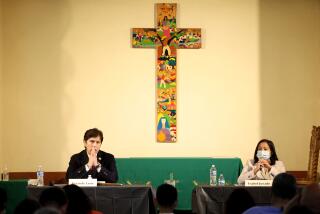The Bishop and the Bureaucrat
The feud between Mayor Tom Bradley and Cardinal Roger Mahony over an anti-gang program involves much more than the colliding egos of two proud and powerful men.
The mayor and the cardinal are fighting about the best way to stop the gang violence that claimed 771 lives in Los Angeles County last year and brought terror to families and neighborhoods from Pomona to Venice.
Mahony, along with Protestant and Jewish religious leaders, is supporting a program called Hope In Youth, based in churches and synagogues throughout the county. At least 160 four-person teams would work with gang-neighborhood families, trying to persuade young people to avoid the gang life. Hope In Youth is seeking about $20 million, most of it from government, for the first year of a five-year program.
Bradley, however, turned down Mahony’s request for $2.5 million in city funds. Hope In Youth, he said, should begin with a small private program and undergo the same scrutiny required of all anti-gang programs competing for scarce government dollars.
But the disagreement goes far beyond procedures for obtaining government money. At the heart of it are two well-intentioned but conflicting visions of how to lead this community out of the wilderness of the ‘90s.
On one side is the intense, impatient prince of the church. In the current fight, he became a prince of the streets, leading 300 of his followers in a march from St. Vibiana’s Cathedral down grimy Main Street to City Hall, demanding an audience with the mayor.
On the other side is the mayor, the icy, remote bureaucrat. Instead of engaging in demonstrations, he has dedicated his professional life to a slow and patient manipulation of an unwieldy political system, a style that angers the cardinal.
I saw the emotion when I recently interviewed Mahony about Hope In Youth. The cardinal digressed, recalling Bradley’s speech at Police Chief Willie Williams’ swearing-in. After the new chief delivered a stirring call to arms, the mayor chilled the audience by saying there was no money to finance it.
“That horrible talk,” is how Mahony described it. “What a complete downer. It is the same kind of talks we’ve been getting about the gang thing. I told the mayor . . . you gave an awful talk at the swearing-in. . . . You should have supported him and said I’m not sure today where we will get the money to do community policing, but we’ve got to make sure the citizens of this city feel safe and secure, and by God . . . we’re going to do it.”
On March 17, when Hope In Youth was unveiled at a South L.A. church, Mahony and other religious leaders met privately with Bradley before a public meeting. “We . . . tried to get a commitment,” Mahony told me. “He kept talking about the budget . . . we kept saying, ‘Mr. Mayor, you as the mayor of this city have to stand up and say out loud to this community we have a terrible gang problem . . . you have never really said that, never really focused on how bad the gang thing is.”’
“What did he say?” I asked.
“He didn’t say anything,” replied Mahony. “He just sat there and then we got to the public part and he just talked again about the budget.”
I can just see the mayor sitting stony-faced, simmering, during the cardinal’s tirade. But it wasn’t only Mahony’s lecture that antagonized Bradley. Mahony’s political methods are also abhorrent to the mayor.
Despite his ecclesiastical eminence, Mahony is a follower of the anti-Establishment politics of the late Saul Alinsky, who organized Chicago’s poor to fight a machine-dominated City Hall. “The only way to upset the power structure is to goad them, confuse them, irritate them,” said Alinsky. His organization, the Industrial Areas Foundation, spread, taking root in poor neighborhoods in East Los Angeles, the San Fernando Valley, the San Gabriel Valley and South L.A. It was organized around churches, especially Catholic parishes.
Mahony had learned the Alinsky method many years before. When he was an auxiliary bishop in the San Joaquin Valley, he helped Alinsky-disciple Cesar Chavez organize the farm workers union. When Mahony became archbishop of Los Angeles seven years ago, he immediately began working with the IAF organizations. In fact, the four IAF organizations, which had demanded more government action against gangs, helped shape the Hope In Youth anti-gang programs.
Alinsky would have cheered Mahony leading his rabble-rousing band down Main Street toward City Hall. But not the mayor. After a half-century in government--as a cop, city councilman and mayor--Bradley believes in rules and procedures. If L.A. is to be saved, it must be done by the book or it won’t be done at all.
More to Read
Sign up for Essential California
The most important California stories and recommendations in your inbox every morning.
You may occasionally receive promotional content from the Los Angeles Times.










